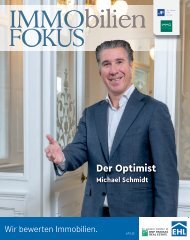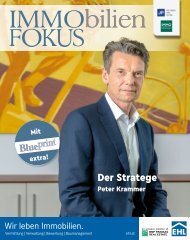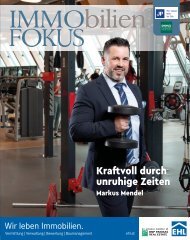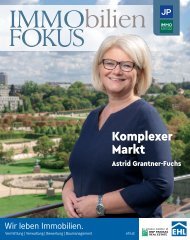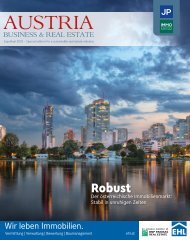MIPIM 2019 (24.1 MB)
You also want an ePaper? Increase the reach of your titles
YUMPU automatically turns print PDFs into web optimized ePapers that Google loves.
VIENNA AT NIGHT<br />
Fotos: A. Karnholz, hurca<br />
burg ranked second and third, respectively. As<br />
in 2017, the information and communication<br />
technology (ICT) sector led the way accounting<br />
for 56 of the newly-established companies, and<br />
the business-related services sector, which attracted<br />
55 companies, also stood out in 2018.<br />
Location loyalty<br />
Domestic companies as well are also constantly<br />
confirming their commitment to Austria<br />
as a business location: Voest, for example,<br />
is investing around 350 million Euros in a new<br />
stainless steel plant in Kapfenberg, the first<br />
one in Europe in 40 years incidentally. Beginning<br />
in 2021, the fully-digitized plant will produce<br />
around 205,000 tonnes of the most demanding<br />
high-performance steel annually. In<br />
the long term the investment will secure more<br />
than 3000 highly-qualified jobs in the region.<br />
In the nearby Leoben, the logistics company<br />
Knapp is also taking a further investment step:<br />
around 3.9 million Euros will be supplied for<br />
the expansion of the company building. The<br />
current workforce of 580 employees is to be<br />
increased to 1000 by 2025. Like these two<br />
examples, numerous other companies, including<br />
many world market leaders and hidden<br />
champions, are remaining loyal to their homeland.<br />
There are various reasons for believing<br />
in Austria as a business location: One of the<br />
most important characteristics is that it is a<br />
quality location. Because the performance<br />
matches the requirements, the companies are<br />
also willing to accept the high labour costs. In<br />
addition, the Alpine republic still scores with<br />
its proximity to Central and Eastern Europe,<br />
as more than 360 Eastern European headquarters<br />
indicate. Other strengths include labour<br />
productivity well above the Eurozone average,<br />
low strike rates, political and legal stability<br />
and high living, social and environmental<br />
standards. The practice-oriented dual education<br />
system and a large number of universities<br />
and advanced technical colleges provide the<br />
highly sought-after, well-trained skilled workers.<br />
Stable energy supplies - also in the form<br />
of ecologically-sustainable energy - are also<br />
becoming increasingly significant. The rising<br />
consumer demand of private households,<br />
based on strong employment growth and<br />
income tax relief, as well as increasing investments<br />
in equipment also confirm the strength<br />
of Austria as a business location.<br />
Innovative Austria<br />
The same applies to the innovative strength<br />
of domestic companies, which is reflected in<br />
rising innovation expenditure and a correspondingly<br />
steady increase in the research quota.<br />
The share of research expenditure in the gross<br />
domestic product is estimated to have risen<br />
from 3.16 to 3.19 per cent in the previous year.<br />
This means that since 2014 the research ratio<br />
has already exceeded the EU target of three<br />
percent by 2020. A total of 12.3 billion Euros<br />
has been invested in research and development<br />
in 2018 - an increase of 5.6 percent compared<br />
to 2017. All this is also reflected in various<br />
location rankings: Austria, for example, ranks<br />
22nd among 140 nations in the current World<br />
Economic Forum (WEF) ranking.<br />
Still some catching up to do<br />
However, it’s not time to rest on one's laurels<br />
just yet, as there are some points in which<br />
<strong>MIPIM</strong> <strong>2019</strong><br />
21




